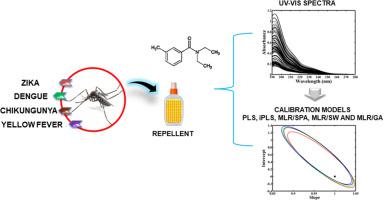Spectrochimica Acta Part A: Molecular and Biomolecular Spectroscopy ( IF 4.4 ) Pub Date : 2020-07-02 , DOI: 10.1016/j.saa.2020.118660 Daniella Iris Oliveira Silva 1 , Welma Thaíse Silva Vilar 2 , Márcio José Coelho Pontes 1

|
In recent years outbreaks of vector-borne diseases have caused great concern to the population, especially those diseases transmitted by mosquitoes. Repellents appear as an affordable alternative for prevention, making it increasingly important to control the quality of these products, since the content of the active ingredients are directly related to the efficiency and the protection time provided by the repellent. This paper proposes an analytical method for determining the DEET (N, N- Diethyl-3-methylbenzamide) content in insect repellents in lotion using UV spectroscopy. For this propose five different strategies of regression were evaluated: (a) Partial Least Squares (PLS) using full-spectrum; (b) interval PLS (iPLS); Multiple Linear Regression (MLR) with variable selection by the (c) Genetic Algorithm (MLR/GA), (d) Successive Projections Algorithm (MLR/SPA) and the (e) Stepwise (MLR/SW). Appropriate predictions were obtained with RMSEP values between 0.88 and 0.93%w w−1. No systematic error was observed and no significant differences were found between the predicted and reference values, according to a paired t-test at 95% confidence level. The results demonstrated the potential of UV spectroscopy associated to multivariate calibration to determine DEET content in repellents as a fast, simple strategy and with a suitable correlation between the values estimated by the model and the reference values.
中文翻译:

化学计量学紫外分光光度法测定驱虫剂中的N,N-二乙基-3-甲基苯甲酰胺。
近年来,媒介传播疾病的爆发引起了人们的极大关注,尤其是蚊子传播的疾病。驱避剂似乎是预防负担得起的替代方法,因此控制这些产品的质量变得越来越重要,因为有效成分的含量直接与驱避剂提供的功效和保护时间有关。本文提出了一种使用紫外光谱法测定乳液中驱蚊剂中DEET(N,N-二乙基-3-甲基苯甲酰胺)含量的分析方法。为此,评估了五种不同的回归策略:(a)使用全光谱的偏最小二乘(PLS);(b)间隔PLS(iPLS);通过(c)遗传算法(MLR / GA),(d)连续投影算法(MLR / SPA)和(e)逐步(MLR / SW)进行变量选择的多元线性回归(MLR)。RMSEP值在0.88%至0.93%ww -1之间获得了适当的预测。根据在95%置信水平下的配对t检验,未观察到系统误差,在预测值和参考值之间未发现显着差异。结果表明,与多变量校准相关的紫外线光谱法具有潜力,可以快速,简单地确定驱虫剂中的DEET含量,并且模型估计的值与参考值之间具有适当的相关性。



























 京公网安备 11010802027423号
京公网安备 11010802027423号